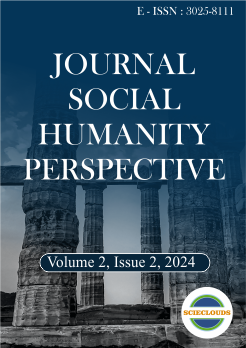Education as a Strategic Pathway for Social Justice and Equity through Institutional Governance and Community Engagement
DOI:
https://doi.org/10.71435/637715Keywords:
Education, Social Justice, Equity, Access, CurriculumAbstract
Since the time of ancient civilization, education has been perceived as an effective channel of promoting social justice and equity, but its contributions have been debatable both in its ability to deconstruct inequalities and its propensity to replicate them. This paper addresses the issue of how education can be used as a transformative tool once equity is used as its core strategy. Using a qualitative method, the study involves teachers, students, parents, administrators, and policymakers in the form of interviews, focus group discussions, classroom observations, and an analysis of documents. The results point to a number of problems that frustrate the good intent of education such as the lack of resources, social discrimination, and unfair policy structures. In the meantime, the study finds the following potentially promising practices to be included: school-community collaboration and affirmative action programmes and teacher training in inclusive pedagogy to be indicators that not only is structural change possible, but also sustainable. The discussion highlights the managerial relevance of making equity central to organizational systems of education, which require redistributive resource policies, culturally responsive leadership, curriculum audits, policy customization, and ethical integration of technology. The study emphasises the importance of understanding equity as an ethical necessity and a strategic necessity by perceiving education as a disciplined institution rather than an apolitical social production. The article also adds to the academic literature on management by providing the framework in which social justice can be used as a measure of institutional legitimacy and efficiency. Lastly, the question of whether education can develop justice, is determined not only by what is desired but also the strategic design of systems, policies and practices aimed at justice, inclusivity and democratic sustainability.
References
Akour, M., & Alenezi, M. (2022). Higher education future in the era of digital transformation. Education Sciences, 12(11), 784. https://doi.org/10.3390/educsci12110784
Anguelov, D. (2021). The geopolitical-economy of infrastructure development and financing: Contesting developmental futures in Indonesia. University of California, Los Angeles.
Balaj, M., York, H. W., Sripada, K., Besnier, E., Vonen, H. D., Aravkin, A., ... & Eikemo, T. A. (2021). Parental education and inequalities in child mortality: a global systematic review and meta-analysis. The Lancet, 398(10300), 608-620. https://doi.org/10.1080/10618600.2020.1868303
Bartlett, A., Faber, S., Williams, M., & Saxberg, K. (2022). Getting to the root of the problem: Supporting clients with lived-experiences of systemic discrimination. Chronic Stress, 6, 24705470221139205. https://doi.org/10.1177/24705470221139205
Bess, J. L., Johnstone, D. B., & Dee, J. R. (2023). Understanding college and university organization: Theories for effective policy and practice: Volume II—Dynamics of the system. Routledge. https://doi.org/10.4324/9781003448457
Cénat, J. M., Darius, W. P., Dalexis, R. D., Kogan, C. S., Guerrier, M., & Ndengeyingoma, A. (2024). Perceived racial discrimination, internalized racism, social support, and self-esteem among Black individuals in Canada: A moderated mediation model. Cultural Diversity & Ethnic Minority Psychology, 30(1), 118.
Dancy, M., & Hodari, A. K. (2023). What a well-intentioned white male physicists maintain ignorance of inequity and justify inaction. International Journal of STEM Education, 10(1), 45. https://doi.org/10.1186/s40594-023-00433-8
Galdon, F. (2021). Designing trust: Evolving models and frameworks towards prospective design futures in highly automated systems. Royal College of Art (United Kingdom).
Kurnia, A. A., Rustiadi, E., Fauzi, A., Pravitasari, A. E., & Ženka, J. (2023). Probing regional disparities and their characteristics in a suburb of a global south megacity: The case of Bekasi regency, Jakarta Metropolitan region. ISPRS International Journal of Geo-Information, 12(2), 32. https://doi.org/10.3390/ijgi12020032
Li, L., & Ruppar, A. (2021). Conceptualizing teacher agency for inclusive education: A systematic and international review. Teacher Education and Special Education, 44(1), 42-59. https://doi.org/10.1177/0888406420926976
Marsico, R. D. (2021). The intersection of race, wealth, and special education: The role of structural inequities in the IDEA. NYL Sch. L. Rev., 66, 207.
Mason-Williams, L., Bettini, E., Morris Mathews, H., Boveda, M., & Rodgers, W. (2023). Disparities in teachers’ access to schools’ collective social assets based on role, race, and poverty. Remedial and Special Education, 44(1), 3-15. https://doi.org/10.1177/07419325211068170
Meikle, P. (2023). Social justice as a dimension of university social responsibility. In Social Inequality-Structure and social processes. IntechOpen. https://doi.org/10.5772/intechopen.109792
Min, M., Lee, H., Hodge, C., & Croxton, N. (2022). What empowers teachers to become social justice-oriented change agents? Influential factors on teacher agency toward culturally responsive teaching. Education and Urban Society, 54(5), 560-584. https://doi.org/10.1177/00131245211027511
Orazani, S. N., Reynolds, K. J., & Osborne, H. (2023). What works and why in interventions to strengthen social cohesion: A systematic review. Journal of Applied Social Psychology, 53(10), 938-995. https://doi.org/10.1111/jasp.12990
Rawe, W. C. (2024). Reimagining the Policies, Practices, and Purposes for Leadership Development Programs (Doctoral dissertation, Grand Canyon University).
Song, Z. (2023). Disparity in educational resources between urban and rural areas in China. Journal of Advanced Research in Education, 2(5), 64-69.
Stephenson, J. H. (2024). Understanding the Role of Allyship as a Tool for Organizational Diversity, Equity, and Inclusion. In Allyship in Organizations: A Comprehensive Analysis from a DEI Perspective (pp. 1-28). Cham: Springer Nature Switzerland. https://doi.org/10.1007/978-3-031-64961-5_1
Sumida, S., & Kawata, K. (2021). An analysis of the learning performance gap between urban and rural areas in sub-Saharan Africa. South African journal of education, 41(2), 1-17.
Thiem, K. C., & Dasgupta, N. (2022). From precollege to career: Barriers facing historically marginalized students and evidence‐based solutions. Social Issues and Policy Review, 16(1), 212-251. https://doi.org/10.1111/sipr.12085
Vadivel, B., Alam, S., Nikpoo, I., & Ajanil, B. (2023). The impact of low socioeconomic background on a child’s educational achievements. Education Research International, 2023(1), 6565088. https://doi.org/10.1155/2023/6565088
Vella-Brodrick, D. A., & Gilowska, K. (2022). Effects of nature (greenspace) on cognitive functioning in school children and adolescents: A systematic review. Educational Psychology Review, 34(3), 1217-1254. https://doi.org/10.1007/s10648-022-09658-5
Downloads
Published
How to Cite
Issue
Section
License
Copyright (c) 2024 Journal Social Humanity Perspective

This work is licensed under a Creative Commons Attribution-ShareAlike 4.0 International License.






